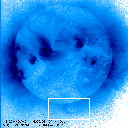JavaScript movie
This week's solar activity included an interesting eruption at a rather high latitude. We have discussed the heliographic latitude of active regions in some previous nuggets ( [1], [2], and others); and frequent readers will remember that activity ordinarily drifts equatorward throughout the sunspot cycle (see the nugget on helioexalepidoptery, and a description of Spoerer's Law).
Disappearing Prominence Material
This week's imagery showed us a large solar prominence on the southeast limb. We begin with a movie from SoHO/EIT, in the 304 Angstrom passband. The prominence is clearly there until about 13:00 UT, and disappears before 19:00.
| Low-resolution MPEG, 180 kbyte | High-resolution GIF, 3.7 Mbyte |
Coronal Signatures
Another view of the prominence disappearance is provided by EIT's 195 A passband. Prominence material can be seen here because it absorbs some of the ultraviolet light coming from behind it. See the movies linked below, and look for the prominence material to disappear.
| Low-resolution MPEG, 155 kbyte | High-resolution GIF, 3.6 Mbyte |
Aside from the disappearance of the dark prominence material, you should also notice that the coronal emission is significantly reduced. This "coronal dimming" is an often-seen signature of the removal of coronal mass. See previous "coronal dimming" nuggets ([1], [2], [3], [4], ).
The Yohkoh SXT images show a difference coronal signature of the eruption, namely the heating of plasmas. In the following two movies, we see different parts of the coronal response to this ejection. The first of the two movies below is based on the full-Sun images (FFIs), and allows a view of the higher-altitude plasma motions. In it we see that some of the coronal structures appear to be "unwinding" as they are pushed out from the Sun. These same features also suggest that the path of the ejection is not strictly radial, but more nearly due south.
The second movie is from the partial-Sun images (PFIs), and reveals a magnetic structure that has come to be considered ubiquitous in coronal mass ejections -- a coronal arcade. The arcade is visible at the beginning of this image sequence, and slowly fades as the plasma cools. By 19:00 UT, it has become nearly invisible. (We apologize for the jumpy appearance of the movie -- we've tried to clean them up as best we can, but the SXT camera was not locked into pointing at a single location during this period).
Conclusion
No dramatic discoveries here, but an observation of an eruption that occurred near the south polar crown, and which seemed to trace out a non-radial path. Some of the standard CME-related signatures were seen, including coronal dimming and a post-eruption arcade. We note that a possible precursor event might have been on 23-nov, when the region was on the backside of the Sun -- as hinted by the single image below.
